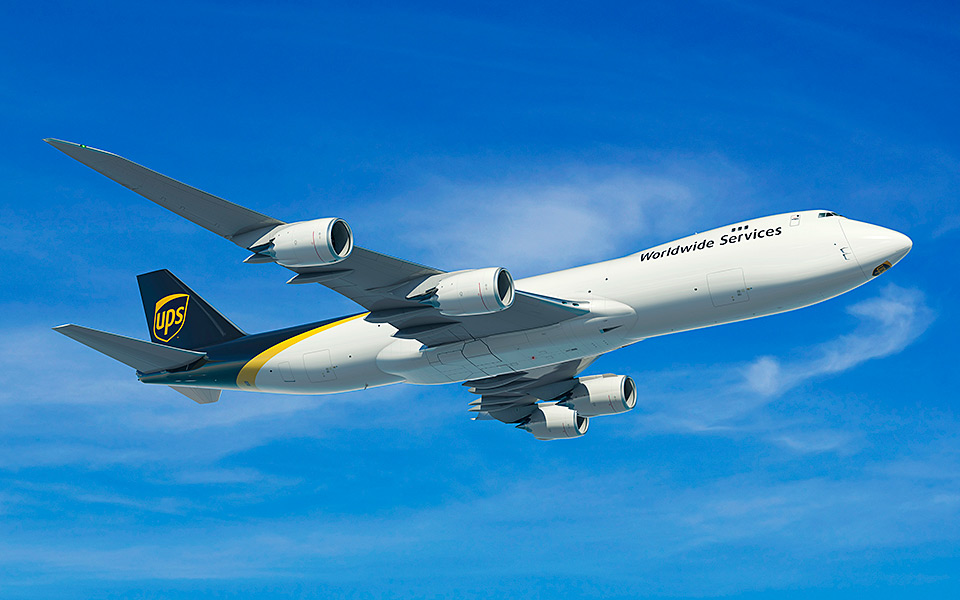Leeham News and Analysis
There's more to real news than a news release.
UPS order tops off 747-8 line through 2020

UPS Boeing 747-8F. Source: Boeing.
Subscription Required
Introduction
Oct. 31, 2016, © Leeham Co.: Last week’s order for 14 Boeing 747-8Fs and 14 options by UPS assures continuation of the program through 2020.
If options are exercised, and if previously announced deals with other customers finally are consummated, the program should continue at least well into the 2020 decade.
Summary
- UPS (but not Boeing) revealed the delivery timeline for the order.
- The mysterious Volga-Dnepr/AirBridgeCargo that was announced at the Paris and Farnborough air shows for up to 20 747-8Fs still hasn’t been firmed up. Only four are listed on the Boeing website this year.
- Iran Air will order four 747-8s under the reported terms of the agreement with Boeing. The US government blessed the deal recently.
- The first of three 747-8s for the presidential fleet is now scheduled for delivery in October 2017, it’s believed.
Pontifications: Hawaiian Air ponders A380
Oct. 31, 2016, © Leeham Co.: Hawaiian Airlines continues to ponder the possibility of acquiring one or two Airbus A380s, its CEO said on the third quarter earnings call—something that raises eyebrows and a lot of questions with industry officials.
Mark Dunkerley, responding to a question on the call, said there are two or three routes that could support the giant A380.
Bjorn’s Corner: Turbofan engine challenges, Part 1
October 28, 2016, ©. Leeham Co: Before we go into the details on the innards of airliner turbofans, we will look at some basics. We do that so that everyone is on the same page.
A turbofan engine generates thrust by pumping air out the back of the engine. This air has a higher speed than surrounding air. Air is actually quite heavy: it weighs 1.2kg per m3 at sea level. By kicking out air at an overspeed in relation to the aircraft, thrust is generated.
In a modern turbofan, the kicking gets done by the fan to 80-90% in the modern By Pass Ratio (BPR) 8-10 engines. A single aisle engine generating 10 tonnes of thrust throws around 350kg of air per second backwards at close to sound speed in a take-off situation. To drive the fan to do that, there is a lot of shaft horse-power needed, around 30,000hp.

Figure 1. Work cycle for jet engine/turbofan core compared to car engine. Source: Rolls-Royce book “The Jet Engine.”
These hp are generated by the core. The thermodynamic cycle to generate all these hp in a jet engine or turbofan core (we call both a gas turbine) is like the one in a normal car engine, Figure 1, with the difference that it is a continuous cycle.
We will now go through this cycle in steps. Read more
Counting down to 737-10, NMA
Subscription Required
Introduction
Oct. 27, 2016, © Leeham Co.: Boeing faces decisions in the near term on whether to proceed with the 737-10 stretch of the MAX 9 and the New Mid-range Airplane (NMA) to serve the Middle of the Market sector (MOM).
The 737-10 is intended to compete with the Airbus A321neo, stemming significant bleed at the top end of the 737 line.
The NMA will address the top end of the MOM sector, carry more passengers and have more range than the Boeing 757 and A321neoLR.
Boeing still has critical issues facing it before proceeding with either airplane.
Summary
- A simple stretch to create the 737-10 has technical and operational issues.
- The proposed date for entry-into-service still gives Airbus an insurmountable lead.
- The market for the 737-10 remains limited. Is the return on investment there?
- The market for the NMA is identified in the abstract—but price will be a key driver.
Boeing beats estimates on one-time gains
![]() Oct. 26, 2016: Boeing Co. beat analyst estimates on one-time gains but also reported that it raised earnings guidance for the full year.
Oct. 26, 2016: Boeing Co. beat analyst estimates on one-time gains but also reported that it raised earnings guidance for the full year.
The press release with full details is here.
Revenues were down 2% year-over-year to $72.1bn. Operating earnings fell 42% to $3.65bn but net earnings fell only 21% due to gains related to taxes. Commercial deliveries were down by 17 airplanes as Boeing transitions from the 737NG to the 737 MAX.
Airbus results depressed from continuing delivery delays
 Oct. 26, 2016: Airbus Group reported that its nine months financial results continue to be depressed by delivery delays in the A320neo and A350-900 programs.
Oct. 26, 2016: Airbus Group reported that its nine months financial results continue to be depressed by delivery delays in the A320neo and A350-900 programs.
The Group reported revenues of €43bn for the period and charges that lowered profits.
Net cash fell by nearly €5bn from the same period last year. Earnings at the Commercial unit fell 59% YOY.
The press release with detailed results may be found here.
Pontifications: Rockwell buying B/E Aerospace: getting out while the getting is good?
Oct. 24, 2016, © Leeham Co.: An announcement Sunday by supplier Rockwell Collins (NYSE:COL) that it will acquire B/E Aerospace (NYSE: BEAV) for $6.5bn caught analysts by surprise. The price tag rises to $8.3bn when assumption of BEAV’s debt is included.
The surprise is not so much BEAV is selling itself. A few years ago, BEAV sold of one of its division and analysts since then believed an exit strategy was underway for the principal owners of the company.
The surprise is that the buyer is Rockwell, a supplier that has little in common with BEAV. A slide from Rockwell’s own investor presentation Sunday illustrates the point.
Rockwell will have an investors’ call Monday at 0830 EDT to further explain the merger.





